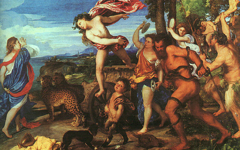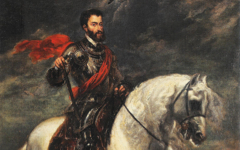Titian’s Assunta (1516-18)

Titian. Assunta (1516-18) Oil on Panel. Santa Maria Gloriosa dei Frari, Venice
Click image to enlarge.
Titian's Assunta (The Assumption of the Virgin) commissioned for the high altar of a major Venetian church is both Titian's first masterpiece and a work of signal importance. For the first time, the normally static figures of an altarpiece are transformed into a swirl of upward motion as the disciples gesture towards the ascending Virgin as though to try and hold back her ascent towards God.
Click next thumbnail to continue
I have argued elsewhere that Michelangelo placed a particular emphasis on hands that he thought of as his own, like those of the drowning man in The Battle of Cascina (left) or those of the Virgin, with whom he also identifed, in the landmark Vatican Pietå. In each case they are the active hands of the artist creating the work we ourselves are looking at. Hands maintain a similar role in Titian's work.
Click next thumbnail to continue
We also know from several extant letters that Titian identified with both Mary Magdalene and the Virgin Mary. Titian, on sending a picture of the Virgin, asked Emperor Charles V for an overdue payment: "My supplication to the Virgin Mary to intercede for me with Your Majesty is shown in her image, which now comes before Your Majesty with an expression of grief which reflects the intensity of my troubles."1 In a sonnet Michelangelo also referred to himself as "God's beautiful bride."2
Here the Virgin's hands, palms open towards us, are painted as many artists might study and sketch their own palms open on their desk.
Click next thumbnail to continue

Details of God's hands, the Virgin's hands and the disciples' hands from Titian's Assunta.
Click image to enlarge.
Once you grasp that the Virgin's hands are really those of the artist, you might notice that God above has the fingers of his right hand (top) in the same position as hers (center). His faces left, hers right. The most prominent disciple too, the one who steps into the image "from the studio", has his hand (bottom) both centered in the composition and facing it as though the hand was flat against the "panel". He too has his fingers in the same position. Other disciples point, a gesture widely used to mean "paint" as we have shown elsewhere. Still others have stiff beards which, while appearing to defy gravity, are "paintbrushes" too, their hairs recalling the stiff bristles of brushes.
Click next thumbnail to continue

Titian. Assunta (1516-18) Oil on Panel. Santa Maria Gloriosa dei Frari, Venice
Click image to enlarge.
The cherub near God holds a wreath with which, perhaps, to crown a poet's head. There is no need of it within the Biblical story. It therefore must signal that God passes his creativity to the Virgin whose own Immaculate Conception inspires artists, like those below, all Titian, who identify with her. Thus, above one of Venice's most important altars Titian has depicted the process of creation in his own mind, just as Michelangelo had done on the Sistine ceiling and was later to do again in the Last Judgment. It demonstrates for those who understand that God passes divine creativity downwards through the Virgin to Titian. Just as Michelangelo did on a even greater scale in the Sistine Chapel, Titian suggests that the only place you will ever find divinity, God or even heaven is inside your own mind.
More Works by Titian
Notes:
1. Rudolf and Margot Wittkower, Born Under Saturn. The Character and Conduct of Artists: A Documented History from Antiquity to the French Revolution (New York: W.W.Norton) 1969, p.266
2. Robert J. Clements, The Poetry of Michelangelo (New York University Press) 1965, p. 45.
Original Publication Date on EPPH: 25 Mar 2012. | Updated: 0. © Simon Abrahams. Articles on this site are the copyright of Simon Abrahams. To use copyrighted material in print or other media for purposes beyond 'fair use', you must obtain permission from the copyright owner. Websites may link to this page without permission (please do) but may not reproduce the material on their own site without crediting Simon Abrahams and EPPH.





